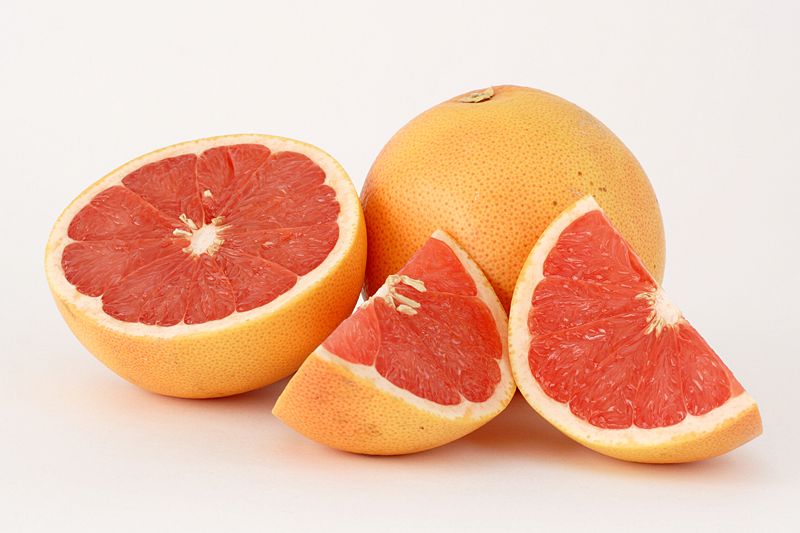List of drugs affected by grapefruit

Grapefruit and grapefruit juice has the potential to interaction with numerous drugs. This is due to the fruit's relatively high concentration of naringin, bergamottin, and dihydroxybergamottin, which interfere with the intestinal enzyme cytochrome P450 isoform CYP3A4. However, bioactive compounds in grapefuit juice may also interfere with p-glycoprotein and organic anion transporting polypeptides (OATPs) either increasing or decreasing bioavailability of a number of drugs.
Affected drugs
Template:Listdev The following drugs interact with CYP3A4:
- Bupropion, amfebutamone, Wellbutrin - rxlist.com
- Valproate semisodium, divalproex sodium, Depakote, Epival - stanford.edu
- Benzodiazepines, including: alprazolam (Xanax), diazepam (Valium), midazolam (Versed), lorazepam (Ativan), oxazepam, and chlordiazepoxide (Librium) - [1]
- The antihistamine astemizole, fexofenadine
Additional drugs found to be affected by grapefruit juice include, but are not limited to:
- Statins such as atorvastatin, lovastatin, and simvastatin [2]
- Dihydropyridines including felodipine (Plendil), nicardipine (Cardene), difedipine, nisoldipine (Sular), nitrendipine (Bayotensin) [3]
- losartan (Cozaar) [4]
- repaglinide (Prandin) [5]
- verapamil (Calan SR, Covera HS, Isoptin SR, Verelan) [6]
- Antiarrhythmics including amiodarone (Cordarone), quinidine (Quinidex, Cardioquin, Quinora), disopyramine (Norpace), propafenone (Rhythmol), and carvediol [7]
- The male impotence drugs sildenafil (Viagra), tadalafil (Cialis), and vardenafil (Levitra) [8] [9]
- The anti-migraine drugs ergotamine (Cafergot, Ergomar) and nimodipine (Nimotop) [10]
Effects on enzymes
Grapefruit juice interacts with many oral drugs. Compounds in the juice including bergamottin, dihydroxybergamottin, and some flavonoids such as naringin effect the activity of certain intestinal enzymes including CYP3A4 and CYP1A2.
These cytochrome P450 enzymes, which metabolize many drugs, are inhibited by grapefruit juice. As a result, serum drug concentrations increase, and may become toxic. This is particularly dangerous when the drug in question has a low therapeutic index, so that a small increase in blood concentration can be the difference between therapeutic success and toxicity. Grapefruit juice only inhibits the enzyme within the intestines, not in the liver or elsewhere in the body, and does not impact injected drugs. The degree of the effect varies widely between individuals and between samples of juice, therefore it cannot be accounted for a priori.
Recently some researchers have shown that furanocoumarins, rather than flavonoids, may be the ingredients causing the various drug interactions.[1]
The flavonoid existing in highest concentration in grapefruit juice is naringin, which in humans is metabolized to naringenin. Other flavonoids exist in grapefruit juice in lower concentrations as well. Orange juice does not contain naringin in as high a concentration, instead containing hesperetin. It is sometimes recommended as a substitute. Juice of limes and Seville oranges can also inhibit drug metabolism, however, as can apple juice with some drugs.[1]
| Drug class | Major Interactions | Minor interactions |
|---|---|---|
| Calcium channel antagonists | Plendil Cardene (Nicardipine) Procardia (Nifedipine) Nimotop Sular DynaCirc | |
| Statins (HMG-CoA reductatase inhibitors) | Mevacor (Lovastatin) | Lipitor Baycol (off the market) |
| Immunosuppressants | Sandimmune (Cyclosporine) Prograf Rapamune | |
| Sedatives, hypnotics, and anxiolytics | Buspar | Halcion Versed Valium (Diazepam) Sonata (Zaleplon) |
| Other psychotropics | Tegretol (Carbamazepine) Desyrel Serzone Seroquel | |
| Antihistamines | Seldane (off the market) Hismanal (off the market) |
Claritin (Loratadine) |
| HIV protease inhibitors | Invirase Norvir Viracept Agenerase | |
| Hormones | Ortho-Cept (Ethinyl estradiol) Depo-Medrol (Methylprednisolone) | |
| Other drugs | Cordarone | Viagra Propulsid |
References
- ↑ 1.0 1.1 1.2 Bakalar, Nicholas (2006-03-21). "Experts Reveal the Secret Powers of Grapefruit Juice". The New York Times. p. F6. Retrieved 2006-11-21.
External links
- Grapefruit-Drug Interaction Website by Canadian Pharmacist Dean Elbe, B.Sc.(Pharm.), BCPP
- USDA Database of Flavonoid content of food
- Arayne M, Sultana N, Bibi Z (2005). "Grape fruit juice-drug interactions". Pak J Pharm Sci. 18 (4): 45–57. PMID 16380358.
- Food—Drug Interactions-Which Ones Really Matter? March 21, 2007